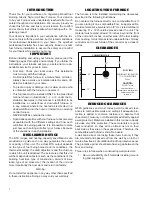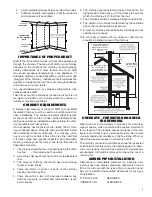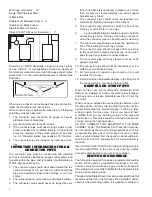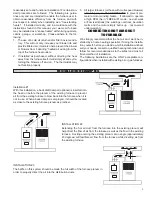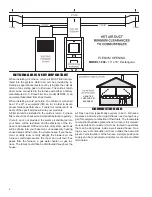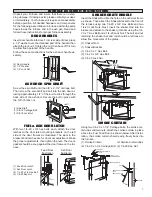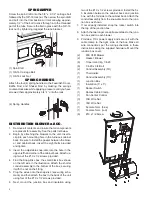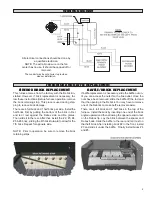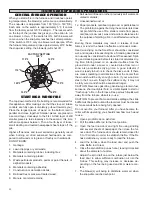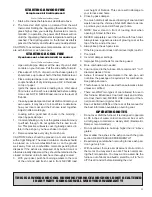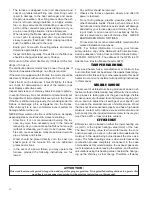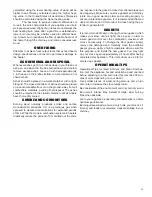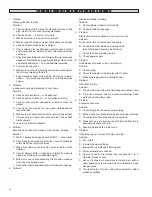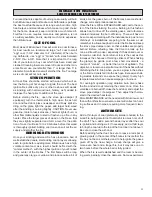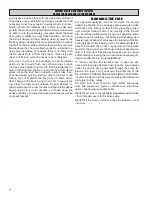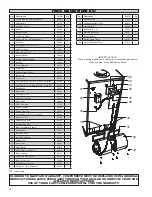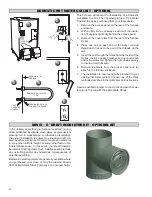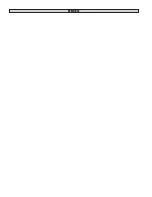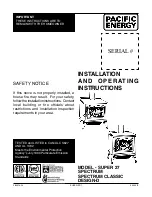
12
• The furnace is designed to burn air dried wood and
coal at a predetermined
fi
ring rate. Over
fi
ring could
result in damage to the heat exchanger and cause
dangerous operation. Over
fi
ring occurs when the ash
door is left open during operation or a highly volatile
fuel, i.e. large amounts of small kindling, is used. If any
portion of the connector pipe glows orange or red, you
are in an over-
fi
ring situation. Close all dampers.
• When tending the
fi
rebox always pull the baf
fl
e slide
rod out prior to opening load door. Open load door
slowly to avoid a “
fl
ash back”. After closing load door,
push the baf
fl
e slide rod to the rear.
• Equip your home with
fi
re extinguishers and smoke
detectors appropriately located.
• Inspect
air
fi
lters regularly. The air
fi
lter in the
fi
lter box
should be changed at least every 30 days.
Oil motor on forced air draft every 90 days with a few
drops o
f 30 wt. oil.
The distribution blower motors may be one of two types. If
the motor has sealed bearings, no oiling is required.
If the motor is equipped with
fi
ll holes, the motor should be
oiled every 90 days with several drops of 30 wt. oil.
Check the
fi
t on the load door. It must
fi
t tightly. If it does
not, check for deterioration or wear of the ceramic rope
seal. Replace defective seals.
Inspect and clean your chimney and stove pipe regularly.
In event of chimney
fi
re, shut all draft controls and call your
fi
re department immediately. Alert everyone in the house.
If the
fi
re is still burning vigorously, throw baking soda into
fi
rebox or discharge a
fi
re extinguisher into the
fi
rebox.
After chimney
fi
re is over, completely inspect system for
damage before further use.
NEVER throw water on the
fi
re or at the furnace, as rapidly
expanding steam could result in a severe scalding.
• Slow
fi
res: It is not recommended burning the fur-
nace any more than necessary early in the fall and
late spring, as you cannot keep the
fi
rebox hot enough
(without overheating your home) to burn gases. Slow
fi
res can cause excessive creosote build-up in smoke
pipe, chimney and
fi
rebox.
• Wood should be placed directly onto the cast iron
shaker grate of the furnace. Do not use additional
grates and/or irons.
• In the event of a power failure, you may operate the
furnace, provided the following instructions are fol-
lowed:
1. Any
air
fi
lter should be removed.
2. Observe the furnace operation closely and often till
power is restored.
• Do not burn garbage, plastics, gasoline, drain oil or
other
fl
ammable liquids. Plastics, when burned, form
hydro
fl
uoric and hydrochloric acids which will damage
and destroy your furnace pipe and chimney. The burn-
ing of trash or oil can result in an extremely hot
fi
re
and is sometimes a cause of chimney
fi
res. NEVER
BURN GREEN WOOD OR TIRES.
•
Do not store fuel or other combustible material within
marked installation clearances.
NOTE: For further information on using your furnace
safely, obtain a copy of the National Fire Protection Asso-
ciation publication “Using Coal and Wood Stoves Safely.”
NFPA NO. NW-8-1974. The address of the NFPA is 470
Atlantic Ave., Boston, Massachusetts 02210.
TAMPER WARNING
This wood heater has a manufacturer-set minimum low
burn rate that must not be altered. It is against federal reg-
ulations to alter this setting or otherwise operate this wood
heater in a manner inconsistent with operating instructions
in this manual.
VISIBLE SMOKE
The amount of visible smoke being produced can be an ef-
fective method of determining how ef
fi
ciently the combus-
tion process is taking place at the given settings. Visible
smoke consist of unburned fuel and moisture leaving your
stove. Learn to adjust the air settings of your speci
fi
c unit
to produce the smallest amount of visible smoke. Wood
that has not been seasoned properly and has a high wood
moisture content will produce excess visible smoke and
burn poorly.Use the included moisture meter to insure your
wood has a 20% or less moisture content.
EFFICIENCY
Ef
fi
ciencies can be based on either the lower heating val-
ue (LHV) or the higher heating value (HHV) of the fuel.
The lower heating value is when water leaves the com-
bustion process as a vapor, in the case of woodstoves the
moisture in the wood being burned leaves the stove as a
vapor. The higher heating value is when water leaves the
combustion process completely condensed. In the case
of woodstoves this would assume the exhaust gases are
room temperature when leaving the system, and therefore
calculations using this heating value consider the heat go-
ing up the chimney as lost energy. Therefore, ef
fi
ciency
ATTENTION:
This wood heater needs periodic inspection and repair for proper operation. It is against federal regulations to operate this
wood heater in a manner inconsistent with operating instructions in this manual.


